WASHINGTON — Defense Secretary Lloyd J. Austin III had a rare phone call with his Russian counterpart in the aftermath of a collision between a Russian warplane and an American spy drone, as senior Pentagon leaders tried to move swiftly to prevent the incident from increasing tensions between the two superpowers.
Mr. Austin said he called Russia’s defense minister, Sergei K. Shoigu, on Wednesday to clear the air. He declined to say whether Mr. Shoigu repeated his country’s denials that a Russian warplane swiped the American MQ-9 Reaper, causing it to crash into the Black Sea, but he said that just having a conversation was important given the events.


“I just got off the phone with my Russian counterpart, Minister Shoigu,” Mr. Austin said at a Pentagon briefing. “As I’ve said repeatedly, it’s important that great powers be models of transparency and communication, and the United States will continue to fly and to operate wherever international law allows.”
Mr. Shoigu countered that the incident was caused by U.S. noncompliance with a flight restriction zone declared by Russia, the Russian Ministry of Defense said in a statement. It called U.S. drone flights off the coast of Crimea “provocative in nature.”
Russia initially denied that its warplanes were to blame, saying in a statement on Tuesday that after the Russian Air Force scrambled fighter jets to identify the drone, the unmanned U.S. aircraft maneuvered sharply, lost altitude and hit the water.
Gen. Mark A. Milley, the chairman of the Joint Chiefs of Staff, also spoke with his Russian counterpart, Gen. Valery V. Gerasimov. The two leaders discussed “several security-related issues of concern,” a spokesman for General Milley said in a short statement.
In the nearly 13 months since Russia invaded Ukraine, General Gerasimov has generally avoided talking to General Milley. The two men last spoke late in October.
The phone calls underscored the seriousness of the drone incident, in which the Pentagon has said it downed the reconnaissance drone in sea after a Russian warplane struck its propeller. It was the first known physical contact between the Russian and U.S. militaries since the war in Ukraine began, bringing the two countries closer to direct conflict at a time when tensions in the region are already high.
The Pentagon has said it was working to declassify surveillance footage from the drone that would show the crash.
General Milley told reporters at the Pentagon that the drone sank into water 4,000 to 5,000 feet deep. That depth, he said, will make its recovery difficult. He said that defense officials have not decided whether they will try to recover the debris, as the United States does not have any naval ships in the Black Sea at the moment. But he indicated that U.S. allies could help recover the drone if necessary.
“There’s probably not a lot to recover, frankly,” General Milley said. “As far as the loss of anything of sensitive intelligence, etc., as normal, we would take and we did take mitigating measures, so we’re quite confident that whatever was of value is no longer of value.”
A defense official said the Pentagon remotely “wiped” sensitive intelligence from the drone. He spoke on the condition of anonymity because he was not authorized to speak publicly.
Russia demanded an end to U.S. military flights near its territory. But Mr. Austin said earlier on Wednesday, at the beginning of a virtual meeting on Ukraine with allies, that the United States would continue to fly spy planes over international waters, including the Black Sea.
The United States and Ukraine say the unarmed American drone was flying in international airspace on a routine surveillance and reconnaissance mission. American and Ukrainian officials have said they share intelligence gathered by such missions, particularly related to the threat posed by Russian warships and submarines in the Black Sea.
New details emerged about what happened in the roughly 40 minutes leading up to the collision. During that time, while the drone was flying at about 25,000 feet, two Russian Su-27 fighter jets made 19 high-speed passes near the Reaper, dumping jet fuel on it during the last three or four, a senior U.S. military official said on Wednesday.
The collision happened on the last pass, as one of the Russian planes approached the drone at a high speed from behind. As the jet pulled up sharply, it collided with the MQ-9’s rear propeller, the official said. ABC News previously reported the details of the collision.
One of the MQ-9’s propeller blades was damaged in the collision, and while there was a temporary loss of contact between the drone and its operators, the controllers ultimately were able to bring down the $32 million aircraft in the sea about 75 miles southwest of Ukraine’s Crimean Peninsula, which Russia has used as a base for launching devastating strikes.
Both Russian warplanes returned to base in Crimea, but it was unclear what damage, if any, the Russian jet involved in the collision suffered, the official said.
Nikolai Patrushev, the secretary of the Russian Security Council, said on Wednesday that Russia was trying to retrieve the wreckage of the drone.
“I don’t know if we will be able to get it or not,” he said. “But we need to do it, and we will definitely work on it. I hope, of course, for success.”
Valerie Hopkins contributed reporting from Berlin.

Tinggalkan Balasan